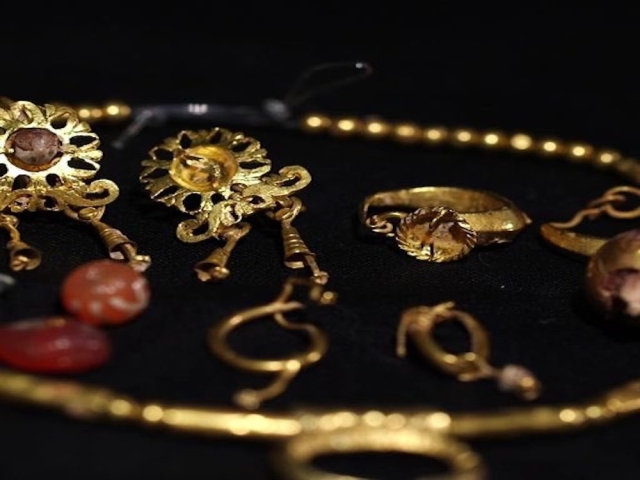Early Monday morning, several impressive gold items discovered more than 50 years ago in burial caves in Jerusalem, were made available for the first time to the public. The jewels found were made out of gold and were found in the graves of girls who lived in the city over 1,800 years ago. The jewelry will be presented for the first time as part of the 48th Israeli Archaeological Congress.
The new research reveals remains of a lead coffin, previously discovered on Mount Scopus, containing jewelry including gold earrings, a pinhead, a gold pendant and beads, carnelian beads, and a glass bead. The findings were discovered in 1971, in an excavation conducted by the late Yael Adler from the Israeli Antiquities Division, but to this day these findings have not been published to the public.
1800-year-old roman style gold jewlery found inside a young girls burial in Jerusalem.
— Philippe Bohstrom (@PhilippeBostrom) April 3, 2023
The set of jewelry, which included earrings, a chain with a lunula pendant (named after the goddess Luna), and a hairpin, revealing that the population in Late Roman times was rich and varied pic.twitter.com/2e7nr62lsA
The jewels were located as part of the Israel Antiquities Authority's "Publishing Obligations of Past Excavations" project, which publishes old archaeological excavations that have not previously reached scientific publication. "The mapping of the information, which laid for years and collected dust in the archive files, along with the physical location of the excavation findings, shed light on long-forgotten archaeological treasures," said Dr. Ayelet Dayan, Director of Research and Specializations at the Antiquities Authority and coordinator of the project. "The beautiful gold jewelry we explored, they are an example of such a treasure."
Dr. Ayelet Dayan, Ayelet Grover, and Dr. Yuval Baruch, all three from the Antiquities Authority, who studied the jewelry, believe that these valuable items, which bear the symbol of the Roman moon goddess Luna, accompanied the girls in their lives as well, and were buried with them so that they would continue to protect them in the 'next world'.
Spectacular gold jewels worn against Evil Eye in Roman Jerusalem go on exhibit, finally https://t.co/8janvWawWM
— Haaretz.com (@haaretzcom) April 3, 2023
According to the research, a pair of similar gold earrings were discovered in another excavation conducted in 1975 on the Mount of Olives in Jerusalem by the late archaeologist Prof. Tsapiris Vasilius of the Antiquities and Museums Division. "The girl was buried with what appears to be a luxurious gold set, which included earrings, a necklace with a pendant lunula, named after the goddess Luna, and a hairpin," said the researchers. "These jewels are known from the Roman world and characterize the burials of children, which can testify to the population buried in these sites.
In Roman Jerusalem, which went by the name Aelia Capitolina, a diverse population existed who came to the city after the destruction of the Second Temple and the forced deportation of the Jewish population. These residents came to the city from different regions throughout the Roman Empire and brought with them a new world of values, beliefs, and worship. The worship of the new inhabitants of the city was diverse and rich and included gods and goddesses, among them, also the worship of the moon goddess Luna.


